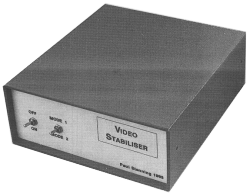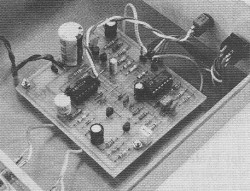|
Schematic
PWB
Silkscreen
Gerber Files
Wiring Diagram
A
friend of the author recently purchased a good secondhand
colour television at a bargain price. The reason for
the bargain price became apparent some weeks later - the set
would not give a stable picture when playing a video tape
that has copy-protection, such as those hired from a video
library.
It was at this point that the author became involved.
The television manufacturer's UK agent was aware of the
problem, but could not offer a modification to resolve it!
The author did not feel inclined to delve into the innards
of the television without information, and his friend didn't
really want to buy another set. The only remaining
option was to design a device to remove the copy-protection
from the signal before it reached the TV. The result
is the Video Stabiliser described here.
Copy Protection
 The principle of copy protection is to alter the video
signal such that it can be displayed normally on a TV or
monitor, but not recorded by a video recorder. By
examining the signal with an oscilloscope, the author found
two areas where it is altered.
The principle of copy protection is to alter the video
signal such that it can be displayed normally on a TV or
monitor, but not recorded by a video recorder. By
examining the signal with an oscilloscope, the author found
two areas where it is altered.
Firstly the video level in the top section of the picture,
normally reserved for teletext information, is varied from
black to peak white. Many video recorders use this
part of the signal to set their automatic recording level,
resulting in a signal with wildly varying amplitude that a
television cannot successfully display.
Secondly the colour burst has a DC offset in the last few
lines of the picture. This is visible on some
televisions as a dark section at the bottom of the screen.
Many video recorders will confuse this with the frame sync
signal, and lock onto it instead of the true frame sync.
The Video Stabiliser presented here will remove both of the
above signal alterations. The prototype enabled the
author's friend to enjoy his new toy! Removal of the
colour burst offset is optional and selected by a front
panel switch. A second switch enables the unit to be
bypassed when not required.
The prototype unit was connected between the video output
connector on the video recorder and the video input
connector on the television. If it is being used with
a television that does not have a composite video input
socket, the signal must be modulated before being fed to the
aerial socket. This can be achieved by connecting the
unit between two video recorders.
How It Works
The complete circuit diagram is shown in fig ?.
The video enters the unit via PL1. SW1 selects whether
the circuit is enabled or bypassed. R8 terminates the
input.
The circuit around TR1 is a sync separator, the output
across R4 pulses between 0V and 6V approx.
TR2 is fed by an integrator circuit to produce the frame
sync. D5, R13 and C9 extend this over the teletext
area at the top of the screen. This is squared up by
the logic gate to form the Blank Enable signal, which is
high during this part of the picture.
If SW2 is closed, D6, C10 and R14 extend the line sync pulse
over the colour burst. The non-extended sync is gated
with this to produce the Burst Enable signal, which is high
during the colour burst.
Video Enable is high whenever the other two enable lines are
low, and covers the normal video and sync part of the
picture.
The Sync signal is inverted by IC1 and R6. This is
then attenuated and set to a suitable DC level by R7, R9,
R12, R13 and C5, and forms the blanked video signal.
The video signal is held with its base line at around 0V by
C7, R10, and D2. This is the normal video. Note
that D2 must be a germanium device.
C6, R16 and R17 remove all DC from the video signal and
leave the chrominance and colour burst, biased a little
above the 0V rail. This forms the chrominance signal.
These three signals are fed into analogue switches
controlled by the enable lines. Only one switch is
closed at a time, and consequently the required signal is
assembled. The result is buffered by the output
amplifier (TR3, TR4 and surrounding components). C13
adds a little HF boost to compensate for losses earlier in
the circuit.
A supply of 9V (+/- 1V) at 35mA is required, this does not
need to be regulated since the current consumption is
reasonably constant. A low cost unit built into a
large 13 Amp plug may be suitable - select one that can be
left on indefinitely. If the voltage is selectable it
may have to be set to 6V since the load is light.
Any ripple on the power supply output is removed by C12.
D5 protects the unit against reverse polarity. The
supply to the sync separator is further decoupled by R19 and
C9.
Note that IC1 and IC2 are operated from a supply of about 6V
(due to R14, R24 and C14). This is because the sync
separator output only goes up to about 6V and a gate powered
from the 9V rail would not respond to it.
Construction
The circuit is constructed on a single sided PCB, 84mm x
92mm. The component overlay is shown in fig ?.
 Construction is reasonably straightforward. Start with
the six wire links, and then continue in the usual size
order. IC1 and IC2 are both CMOS devices and IC
sockets are recommended. D2 is a germanium diode, take
care to ensure that it does not get too hot. Veropins
or 0.1" header strip are recommended for the off-board
connection.
Construction is reasonably straightforward. Start with
the six wire links, and then continue in the usual size
order. IC1 and IC2 are both CMOS devices and IC
sockets are recommended. D2 is a germanium diode, take
care to ensure that it does not get too hot. Veropins
or 0.1" header strip are recommended for the off-board
connection.
Any case that is large enough to hold the PCB, sockets and
switches would be suitable. A metal case may be
preferable for screening but no problems were experiences
with the prototype in its plastic box.
The interwiring is shown in fig ?. Screened cable may
be used for the video connections, but this is not really
necessary providing the wire is short.
The two switches can be considered as optional - if one or
both are not required link wires should be fitted in the PCB
as required.
Testing
Providing the unit is carefully constructed there is no
reason why it shouldn't work first time. If an
oscilloscope is available, the output can be viewed when
playing a copy-protected tape to verify that the offending
signals have been removed. Otherwise simply connect
the unit to your equipment and try it!
Measure the voltage across C12, which must be 9V +/-1V.
If the voltage is selectable on the PSU, try other settings
to bring the voltage within range.
Alternatively, if the voltage is a little too high it may be
possible to reduce it by connecting one or more 1N4001
diodes in series, in the positive connection to the PCB.
Each diode will drop about 0.6V.
In some cases a dark section may be visible at the top of
the screen. This is caused by the delay produced by
R15 and C8 being longer than required. It appears that
this delay differs slightly with different makes of 4001 IC,
however the colour burst delay due to C10 and R18 is
unaffected.
If this problem occurs there are two options. If you
have a stock of IC's try some other 4001's to find one
that's suitable. Otherwise try reducing the value of
R15 to 27K or 22K, find the highest value where the dark
section is not visible.
In Use
For normal viewing it may be preferable to set SW1 to
bypass, to eliminate the inevitable slight signal degrading
that this unit causes. When viewing a troublesome
video film, the unit should be switched in. SW2 should
only be closed if it proves necessary, since this may cause
slight colour variation problems.
Please do not use this unit for any other purpose!
Parts List
Resistors
(All 0.25W 5% or better)
R1,2
27K
R3,18 18K
R4
5K6
R5
22K
R6,9,11 4K7
R7
39K
R8,23 82R
R10
100K
R12
270K
R13
10K
R14
470R
R15,16 33K
R17,20,24 1K0
R19
270R
R21,25 100R
R22
2K2
Capacitors
C1,7
220n
C2,13 100u
C3,4
10n
C5
10u
C6, 11 220p
C8
100n
C9
220u
C10
470p
C12
2200u
C14
47u
Semiconductors
IC1
4066
IC2
4001
TR1,4 BC558
TR2
BC548
TR3
BF244A
D1,3,4 1N4148
D2
OA47
D5
1N4001
Miscellaneous
PL1,3 BNC
Socket (or as required)
PL2
2.1mm Power Socket (or as required)
SW1
DPDT Miniature Toggle Switch
SW2
SPST Miniature Toggle Switch
PCB, Case, Power Supply (see text), Veropins, Wire, PCB
Mounting Hardware, Video Cable and Connectors as Required.
Buylines
All components are readily available and no buying problems
are envisaged.
The electrolytic capacitors should be rated at 16V or
greater, and be radial types. The other capacitors
should have a lead pitch of 0.2" (5mm), other types may
fit if the leads are bent.
Before purchasing a power supply, check the latest Greenweld
bargain list. They often list suitable types for about
two or three pounds.
|
 The principle of copy protection is to alter the video
signal such that it can be displayed normally on a TV or
monitor, but not recorded by a video recorder. By
examining the signal with an oscilloscope, the author found
two areas where it is altered.
The principle of copy protection is to alter the video
signal such that it can be displayed normally on a TV or
monitor, but not recorded by a video recorder. By
examining the signal with an oscilloscope, the author found
two areas where it is altered. Construction is reasonably straightforward. Start with
the six wire links, and then continue in the usual size
order. IC1 and IC2 are both CMOS devices and IC
sockets are recommended. D2 is a germanium diode, take
care to ensure that it does not get too hot. Veropins
or 0.1" header strip are recommended for the off-board
connection.
Construction is reasonably straightforward. Start with
the six wire links, and then continue in the usual size
order. IC1 and IC2 are both CMOS devices and IC
sockets are recommended. D2 is a germanium diode, take
care to ensure that it does not get too hot. Veropins
or 0.1" header strip are recommended for the off-board
connection.